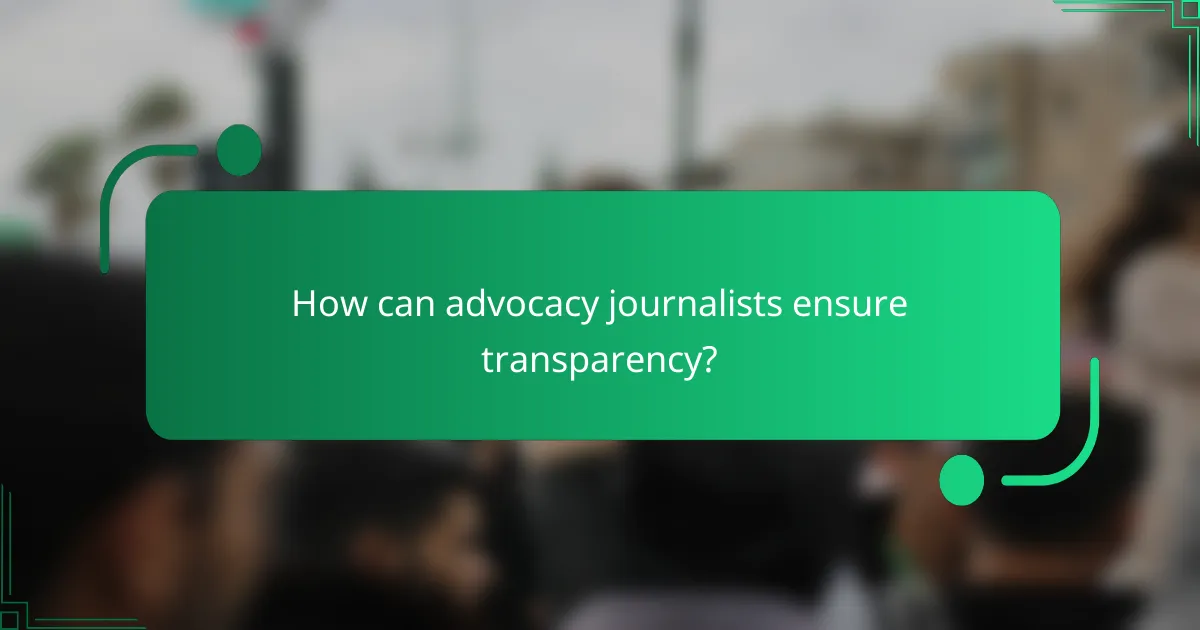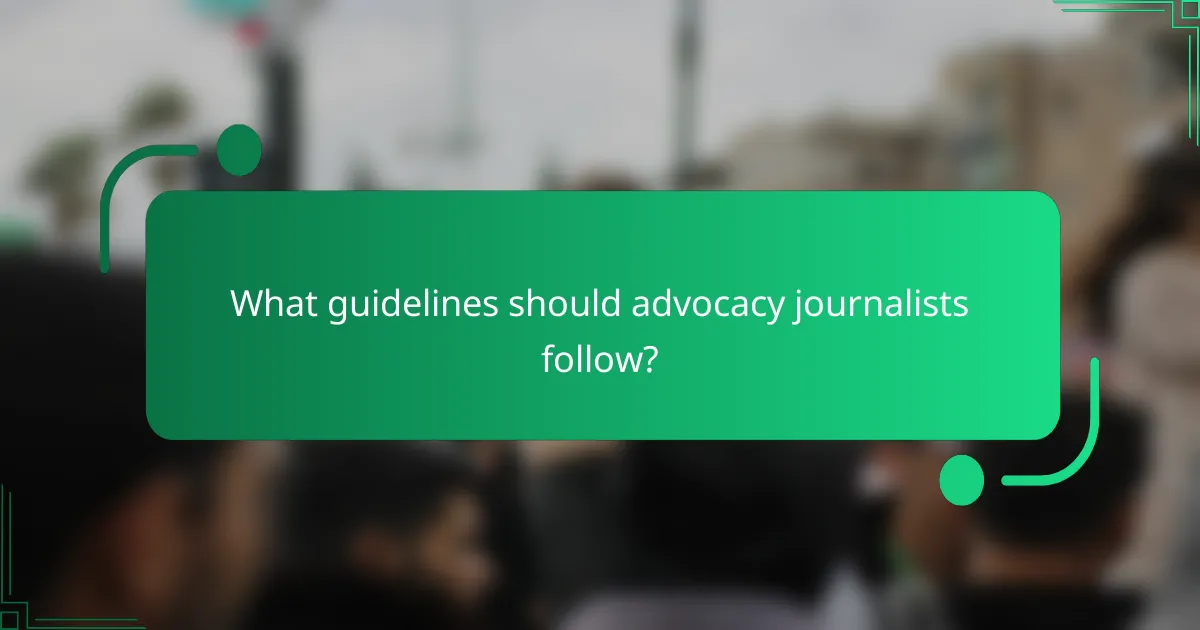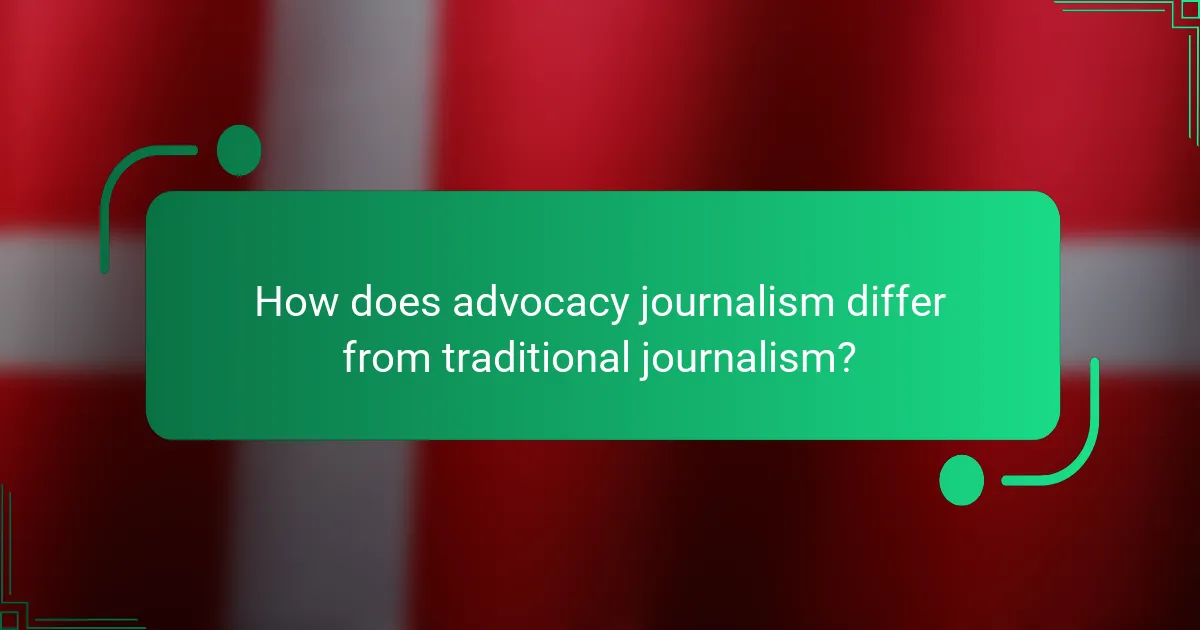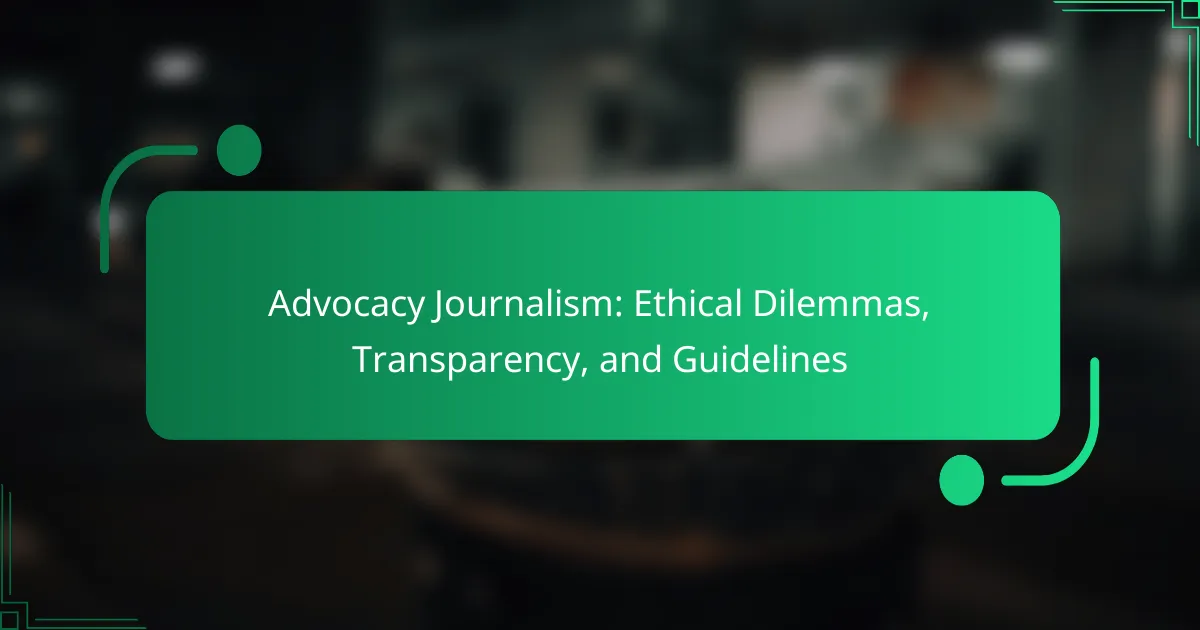Advocacy journalism plays a crucial role in promoting social causes but often grapples with ethical dilemmas that test the boundaries of journalistic integrity. Issues such as conflicts of interest and bias can undermine public trust, making transparency essential. By openly disclosing funding sources and adhering to ethical guidelines, advocacy journalists can maintain credibility while effectively raising awareness on important issues.

What are the ethical dilemmas in advocacy journalism?
Advocacy journalism often faces ethical dilemmas that challenge the balance between promoting a cause and maintaining journalistic integrity. Key issues include conflicts of interest, bias in reporting, and the impact on public trust.
Conflicts of interest
Conflicts of interest arise when a journalist’s personal beliefs or affiliations compromise their objectivity. For instance, a journalist advocating for a specific environmental cause may struggle to report neutrally on opposing viewpoints.
To navigate these conflicts, journalists should disclose any affiliations that could influence their reporting. Transparency helps maintain credibility and allows audiences to assess potential biases.
Bias in reporting
Bias in reporting can manifest when journalists selectively present facts that support their advocacy, leading to skewed narratives. This can undermine the objectivity expected in journalism, making it crucial to provide balanced perspectives.
To minimize bias, journalists should strive to include diverse viewpoints and verify information from multiple sources. Adopting a clear editorial policy can also help maintain fairness in coverage.
Impact on public trust
The ethical dilemmas in advocacy journalism can significantly affect public trust. When audiences perceive bias or conflicts of interest, they may question the reliability of the information presented.
Building and maintaining trust requires consistent transparency and accountability. Journalists should engage with their audience, addressing concerns and clarifying their reporting processes.
Accountability issues
Accountability issues arise when advocacy journalists fail to adhere to ethical standards, leading to misinformation or misrepresentation. This can damage both the journalist’s reputation and the credibility of the advocacy they support.
Establishing clear guidelines and adhering to established journalistic ethics can enhance accountability. Regular reviews of reporting practices can help identify areas for improvement.
Influence of funding sources
The influence of funding sources is a significant ethical dilemma in advocacy journalism. When organizations or individuals fund journalistic efforts, there may be pressure to align content with the funders’ interests.
To mitigate this risk, journalists should disclose funding sources and ensure editorial independence. Clear separation between funding and editorial decisions can help maintain integrity and trustworthiness in reporting.

How can advocacy journalists ensure transparency?
Advocacy journalists can ensure transparency by openly sharing their funding sources, clarifying their editorial independence, and providing clear source attribution. These practices help build trust with the audience and uphold ethical standards in journalism.
Disclosing funding sources
Disclosing funding sources is crucial for advocacy journalists to maintain credibility. By clearly stating who finances their work, journalists can help audiences understand potential biases or influences on their reporting. For example, if a nonprofit organization funds a story, this should be made explicit to avoid misleading readers.
Journalists should consider using a standardized format for disclosing funding, such as a dedicated section on their website or at the end of articles. This transparency can enhance the perceived integrity of their work and foster a more informed readership.
Clarifying editorial independence
Clarifying editorial independence involves stating how funding does not influence content decisions. Advocacy journalists should communicate that their editorial choices are made without interference from sponsors or donors. This can be articulated in mission statements or through disclaimers in articles.
To reinforce this independence, journalists can adopt policies that separate funding from editorial processes. For instance, establishing an independent editorial board can help ensure that content remains unbiased and focused on journalistic integrity.
Providing source attribution
Providing source attribution is essential for transparency in advocacy journalism. Citing sources not only lends credibility to the information presented but also allows readers to verify claims. Journalists should strive to attribute information to original sources, whether they are studies, interviews, or expert opinions.
Using clear and consistent citation methods, such as hyperlinks or footnotes, can enhance the reader’s ability to trace information back to its origin. This practice not only supports transparency but also encourages accountability among sources and journalists alike.

What guidelines should advocacy journalists follow?
Advocacy journalists should adhere to a set of guidelines that prioritize ethical standards, transparency, and factual integrity. These guidelines help maintain credibility while effectively promoting social change and raising awareness on critical issues.
Adhering to ethical codes
Advocacy journalists must follow established ethical codes, such as those outlined by the Society of Professional Journalists (SPJ) or similar organizations. These codes emphasize principles like honesty, fairness, and accountability, which are essential for maintaining public trust.
Journalists should avoid conflicts of interest and disclose any affiliations that may influence their reporting. For example, if a journalist is involved with a nonprofit organization, they should clearly state this connection when covering related topics.
Engaging with diverse perspectives
In advocacy journalism, it is crucial to engage with a variety of viewpoints to present a balanced narrative. This includes seeking out voices from different communities, especially those directly affected by the issues being reported. By incorporating diverse perspectives, journalists can enrich their stories and foster understanding.
Journalists should strive to include marginalized voices that may not have equal representation in mainstream media. This can involve conducting interviews, gathering testimonials, or collaborating with local organizations to ensure comprehensive coverage of the topic.
Maintaining factual accuracy
Factual accuracy is paramount in advocacy journalism. Journalists must verify information from multiple credible sources before publication to avoid spreading misinformation. This practice not only enhances the reliability of the reporting but also strengthens the advocacy efforts.
Utilizing fact-checking tools and cross-referencing data can help ensure accuracy. For instance, when reporting on statistics related to social issues, journalists should cite reputable studies or government reports to support their claims. Regularly updating information as new data becomes available is also essential for maintaining credibility.

What are the best practices for ethical advocacy journalism?
Best practices for ethical advocacy journalism include transparency, accountability, and a commitment to factual reporting. Journalists should prioritize integrity while advocating for social change, ensuring their work is both impactful and trustworthy.
Implementing peer reviews
Peer reviews are essential in maintaining the credibility of advocacy journalism. By having fellow journalists or experts evaluate content before publication, potential biases and inaccuracies can be identified and corrected. This process fosters a culture of accountability and enhances the overall quality of reporting.
To implement effective peer reviews, establish a network of trusted colleagues who can provide constructive feedback. Aim for a diverse group to ensure a range of perspectives, which can help mitigate individual biases.
Conducting audience feedback sessions
Audience feedback sessions allow journalists to understand how their advocacy efforts resonate with the public. Gathering insights directly from the target audience can highlight areas of concern and improve the relevance of the content produced. This practice encourages engagement and builds trust between journalists and their audience.
Consider organizing focus groups or surveys to collect feedback. Aim for a representative sample of your audience to ensure that the insights gathered reflect a broad spectrum of views and experiences.
Utilizing fact-checking tools
Fact-checking tools are vital for ensuring the accuracy of information in advocacy journalism. These resources help verify claims and provide evidence-based support for arguments, which is crucial in maintaining credibility. Journalists should incorporate these tools into their research process to uphold high standards of truthfulness.
Popular fact-checking tools include Snopes, FactCheck.org, and PolitiFact. Familiarize yourself with these resources and integrate them into your workflow to streamline the verification process and enhance the reliability of your reporting.

How does advocacy journalism differ from traditional journalism?
Advocacy journalism focuses on promoting a specific cause or viewpoint, contrasting with traditional journalism’s aim for objectivity and impartiality. While traditional journalists strive to present balanced perspectives, advocacy journalists actively support particular issues, often aiming to influence public opinion or policy.
Focus on specific causes
Advocacy journalism centers on particular social, political, or environmental issues, seeking to raise awareness and drive change. Journalists in this field often align themselves with movements or organizations that reflect their values, which can lead to passionate storytelling and compelling narratives.
For example, an advocacy journalist might cover climate change by highlighting the impacts on vulnerable communities, using personal stories to illustrate broader trends. This approach can mobilize readers and encourage them to take action, such as participating in protests or supporting relevant legislation.
However, focusing on specific causes can create ethical dilemmas, as journalists must balance their commitment to advocacy with the need for factual accuracy. Maintaining transparency about their affiliations and intentions is crucial to uphold credibility and trust with their audience.
